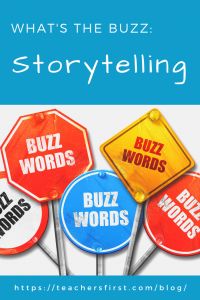World Storytelling Day is just around the corner. As the world gets ready to celebrate the art of oral storytelling, it seemed the perfect time to ponder the instructional case for storytelling.
Storytelling is an ancient interactive art form in which one conveys a tale with gestures, words, and sounds while encouraging the listener to use their imaginations. In the ancient world, it was the way that people shared their beliefs, learned history, and received the news. Before print was widely available, every culture had a Bard, Gusan, Troubadour, Seanchaidh, Griot, or storyteller with some other moniker. In the modern world, storytelling continues to be significant as it relates to organizational strategy, workplace influence, and career success.
The National Council of Teachers of English (NCTE) reminds us that storytelling has several instructional applications. Their storytelling position statement tells us that storytelling is an oral language skill from which all students can benefit. Listening to stories helps students learn vocabulary and language patterns which in turn helps develop their reading skills. Also, students can rehearse their original stories before writing them to become better writers.
Storytelling has other benefits beyond language arts. It can help lay the foundation for cross-cultural understanding as students find similarities between themselves and the characters in a story. Students who participate in storytelling activities can better recognize emotion and emotional needs, making it a perfect opening for social and emotional learning (SEL) activities. Storytelling is one of the best ways to convey factual information for retention. Science tells us that storytelling is a proven way to structure the instructional environment to invoke intelligence.
Using Stories in Instruction
There are many reasons for an educator to use stories to assist with instruction. Stories can provide foundational knowledge on which to build new skills, provide a bridge that allows for the communication of complex information in more accessible ways, and can be used at the beginning of an instructional set to get your students’ attention. Instructors can also use stories to summarize the information presented during a class.
Research tells us that there are four types of story-based instruction:
- Case Studies – Case studies provide a problem with a fixed solution. The student interacts with the story as an observer of events that happened in the past. Students can study cases to learn to recognize patterns that will help them make decisions in the future. For example, high school students learning about the first amendment might explore the Freedom in the Balance collection of case studies provided by NewseumED (reviewed here).
- Narrative Stories – Narrative stories also describe a problem that already has a solution. However, the purpose is to engage or entertain the student. Narratives can be factual or fictionalized and told from the narrator’s point of view. These are the types of stories used in EVERFI’s financial literacy course for middle school (reviewed here).
- Scenarios – While scenarios still have a fixed solution, they allow students to try out various solutions to understand the problem. The approach is a more constructivist approach to using stories in the classroom. Scenarios are the basis for many of the games at iCivics (reviewed here).
- Problem-based stories – The one type of story without a defined solution is the problem-based story. Students in small groups engage the problem-based story and other materials to understand a concept and determine what additional information they might need to solve the given problem. Bill Chapman shares a few of these types of stories on his website (reviewed here)
Engaging students emotionally with stories helps them buy into the instructional set and makes even complex content more approachable. Storytelling in the classroom shouldn’t end with instructional stories. Students need to tell their own stories.
Student Stories
World Storytelling Day is an excellent opportunity to have students practice their storytelling skills. Storytelling falls under the Social Sciences Humanities & Arts for the People & the Economy (SHAPE) umbrella. SHAPE skills – which can be hard to measure – help us contribute to society’s cohesiveness, understand human behavior, and foster the wider population’s wellbeing. These are the disciplines that have helped us to survive the pandemic emotionally.
When introducing storytelling to students, help them recognize it as an art form by sharing storytelling techniques in a lesson similar to this one shared by Mensa For Kids. Students familiar with these skills have a better understanding of story structure and can leverage that to help with reading comprehension and writing. Allowing students to tell their own stories or stories from their cultural backgrounds can be a culturally sustaining pedagogical practice.
If you are looking for ways to inspire creative storytelling in your classroom, try these:
- Write About (reviewed here) – Go to the “Explore Ideas” tab of this website to investigate a treasure trove of storytelling ideas. You can search the free prompts by grade level, category, and genre.
- The Art of Storytelling (reviewed here) – This Khan Academy and Pixar collaboration share several exercises and activities about storytelling, characters, and story structure, among other things. The activities can be completed directly at the site or assigned in Google Classroom.
- Writing Exercises (reviewed here) – This site supports writing stories and can provide support for telling stories. Try the random plot, random subject, or random first-line generators.
Do you use storytelling in your classroom? Let us know how in the comments below.


